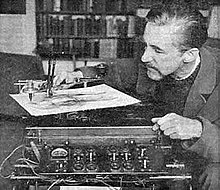Desmond Paul Henry
| Desmond Paul Henry | |
|---|---|

Henry with one of his analogue computer-based drawing machines, 1962
|
|
| Born | 1921 |
| Died | 2004 |
| Nationality | British |
| Notable work | Outputs of Drawing Machine 1 |
| Movement | Computer art |
| Website | http://www.desmondhenry.com/ |
Desmond Paul Henry (1921–2004) was a Manchester University Lecturer and Reader in Philosophy (1949–82). He was one of the first British artists to experiment with machine-generated visual effects at the time of the emerging global computer art movement of the 1960s (The Cambridge Encyclopaedia 1990 p. 289; Levy 2006 pp. 178–180). During this period, Henry constructed a succession of three drawing machines from modified bombsight analogue computers which were employed in World War II bombers to calculate the accurate release of bombs onto their targets (O'Hanrahan 2005). Henry's machine-generated effects resemble complex versions of the abstract, curvilinear graphics which accompany Microsoft's Windows Media Player. Henry's machine-generated effects may therefore also be said to represent early examples of computer graphics: "the making of line drawings with the aid of computers and drawing machines". (Franke 1971, p. 41)
During the 1970s Henry focussed on further developing his own unique techniques for the production of original visual effects. He went on to make a fourth and a fifth drawing machine in 1984 and 2002 respectively. These later machines however, were based on a mechanical pendulum design and not bombsight computers. (O'Hanrahan 2005)
It was thanks to artist L. S. Lowry, working in collaboration with the then director of Salford Art Gallery, A. Frape, that Henry's artistic career was launched in 1961 when he won a local competition at Salford Art gallery, entitled London Opportunity. The prize for winning this competition was a one-man exhibition show in London at the Reid Gallery. Lowry knew how crucial such a London show could be in bringing an artist to public attention. As one of the competition judges, Lowry visited Henry's home in Burford Drive, Manchester, to view his range of artistic work. (O'Hanrahan 2005)
It was at this London show of 1962, entitled Ideographs, that Henry's machine-generated effects were exhibited for the first time, along with pictures based upon Henry's photo-chemical techniques which had originally won him the competition prize. (O'Hanrahan 2005) It was this first exhibition of machine-produced effects which led to Henry and his first drawing machine being included in the first ever programme in the BBC's North at Six series and to his being approached by the American magazine Life. (O'Hanrahan 2005) Henry and his first drawing machine were to be featured in this magazine, but the article was scrapped following the assassination of US President John F. Kennedy. The generally positive response his pictures received reflects the zeitgeist of technological optimism of the 1960s. (O'Hanrahan 2005) The Guardian of 17/9/62 described the images produced by this first machine as being "quite out of this world" and "almost impossible to produce by human hands".
...
Wikipedia
